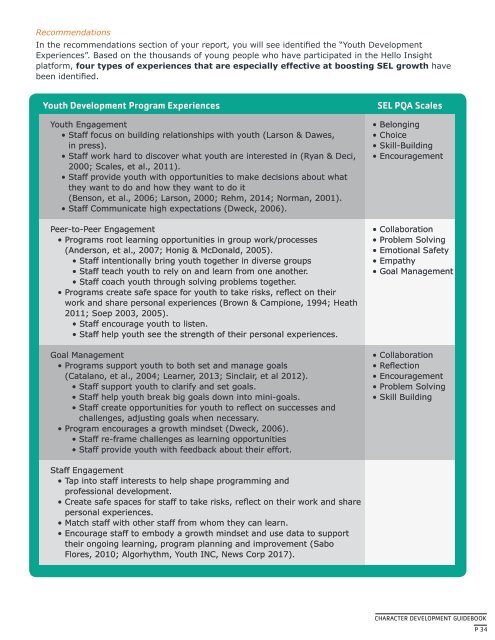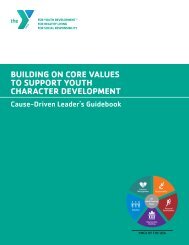CDLI_Guidebook_18_Final_Print
You also want an ePaper? Increase the reach of your titles
YUMPU automatically turns print PDFs into web optimized ePapers that Google loves.
Recommendations<br />
In the recommendations section of your report, you will see identified the “Youth Development<br />
Experiences”. Based on the thousands of young people who have participated in the Hello Insight<br />
platform, four types of experiences that are especially effective at boosting SEL growth have<br />
been identified.<br />
Youth Development Program Experiences<br />
Youth Engagement<br />
• Staff focus on building relationships with youth (Larson & Dawes,<br />
in press).<br />
• Staff work hard to discover what youth are interested in (Ryan & Deci,<br />
2000; Scales, et al., 2011).<br />
• Staff provide youth with opportunities to make decisions about what<br />
they want to do and how they want to do it<br />
(Benson, et al., 2006; Larson, 2000; Rehm, 2014; Norman, 2001).<br />
• Staff Communicate high expectations (Dweck, 2006).<br />
Peer-to-Peer Engagement<br />
• Programs root learning opportunities in group work/processes<br />
(Anderson, et al., 2007; Honig & McDonald, 2005).<br />
• Staff intentionally bring youth together in diverse groups<br />
• Staff teach youth to rely on and learn from one another.<br />
• Staff coach youth through solving problems together.<br />
• Programs create safe space for youth to take risks, reflect on their<br />
work and share personal experiences (Brown & Campione, 1994; Heath<br />
2011; Soep 2003, 2005).<br />
• Staff encourage youth to listen.<br />
• Staff help youth see the strength of their personal experiences.<br />
Goal Management<br />
• Programs support youth to both set and manage goals<br />
(Catalano, et al., 2004; Learner, 2013; Sinclair, et al 2012).<br />
• Staff support youth to clarify and set goals.<br />
• Staff help youth break big goals down into mini-goals.<br />
• Staff create opportunities for youth to reflect on successes and<br />
challenges, adjusting goals when necessary.<br />
• Program encourages a growth mindset (Dweck, 2006).<br />
• Staff re-frame challenges as learning opportunities<br />
• Staff provide youth with feedback about their effort.<br />
SEL PQA Scales<br />
• Belonging<br />
• Choice<br />
• Skill-Building<br />
• Encouragement<br />
• Collaboration<br />
• Problem Solving<br />
• Emotional Safety<br />
• Empathy<br />
• Goal Management<br />
• Collaboration<br />
• Reflection<br />
• Encouragement<br />
• Problem Solving<br />
• Skill Building<br />
Staff Engagement<br />
• Tap into staff interests to help shape programming and<br />
professional development.<br />
• Create safe spaces for staff to take risks, reflect on their work and share<br />
personal experiences.<br />
• Match staff with other staff from whom they can learn.<br />
• Encourage staff to embody a growth mindset and use data to support<br />
their ongoing learning, program planning and improvement (Sabo<br />
Flores, 2010; Algorhythm, Youth INC, News Corp 2017).<br />
CHARACTER DEVELOPMENT GUIDEBOOK<br />
P 34



